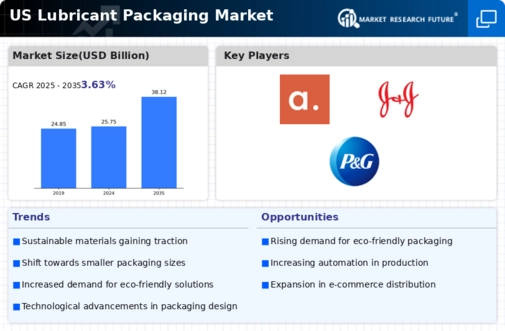Growth of E-Commerce and Online Sales
The lubricant packaging market is significantly influenced by the growth of e-commerce and online sales channels. As consumers increasingly turn to online platforms for purchasing lubricants, the demand for packaging that is both functional and visually appealing has surged. Data indicates that e-commerce sales in the lubricant sector have risen by approximately 15% in the past year alone. This trend necessitates packaging that not only protects the product during transit but also attracts consumers' attention in a crowded digital marketplace. Companies are adapting their packaging strategies to enhance shelf appeal and ensure that products stand out online. Additionally, the rise of subscription services for lubricants further drives the need for innovative packaging solutions that cater to recurring deliveries. Consequently, the lubricant packaging market is likely to evolve in response to these changing consumer behaviors.
Increased Focus on Safety and Compliance
Safety and compliance are paramount in the lubricant packaging market, particularly in the context of stringent regulations governing hazardous materials. The U.S. Environmental Protection Agency (EPA) has established guidelines that dictate the types of materials and packaging methods that can be used for lubricants. Companies are increasingly investing in packaging solutions that meet these regulatory requirements, ensuring that their products are safe for consumers and the environment. This focus on compliance not only mitigates legal risks but also enhances brand reputation. Furthermore, the market is witnessing a rise in demand for tamper-evident and child-resistant packaging, which adds an additional layer of safety. As a result, manufacturers are likely to prioritize compliance-driven innovations in their packaging strategies, thereby influencing the overall dynamics of the lubricant packaging market.
Rising Demand for Eco-Friendly Packaging
The lubricant packaging market is experiencing a notable shift towards eco-friendly packaging solutions. As consumers become increasingly aware of environmental issues, there is a growing demand for sustainable materials. This trend is reflected in the market, where biodegradable and recyclable packaging options are gaining traction. According to recent data, the eco-friendly packaging segment is projected to grow at a CAGR of approximately 8% over the next five years. Companies are investing in research and development to create innovative packaging that minimizes environmental impact. This shift not only aligns with consumer preferences but also helps companies comply with stringent regulations regarding waste management and sustainability. As a result, the lubricant packaging market is likely to see a significant transformation, with eco-friendly options becoming standard.
Consumer Preference for Convenience Packaging
Consumer preferences are increasingly leaning towards convenience in the lubricant packaging market. As lifestyles become busier, there is a growing demand for packaging that is easy to use and store. This trend is evident in the rising popularity of single-use and resealable packaging options, which cater to consumers seeking efficiency. Data suggests that convenience-oriented packaging solutions have seen a growth rate of around 10% in recent years. Manufacturers are responding by designing packaging that simplifies the dispensing process and enhances user experience. Additionally, the trend towards smaller, portable packaging formats is gaining traction, particularly among consumers who prioritize ease of transport. This shift towards convenience is likely to influence product development strategies within the lubricant packaging market, as companies strive to meet evolving consumer expectations.
Technological Innovations in Packaging Materials
Technological advancements are playing a crucial role in shaping the lubricant packaging market. Innovations in materials science have led to the development of packaging solutions that offer enhanced durability, barrier properties, and cost-effectiveness. For instance, the introduction of advanced polymers and composites is enabling manufacturers to create lighter and more resilient packaging. This not only reduces shipping costs but also minimizes the environmental footprint. Furthermore, smart packaging technologies, such as QR codes and RFID tags, are being integrated into lubricant packaging to provide consumers with additional product information and enhance traceability. These technological innovations are likely to drive competition among manufacturers, as they seek to differentiate their products in a crowded market. As a result, the lubricant packaging market is expected to witness a wave of new products that leverage these advancements.














Leave a Comment